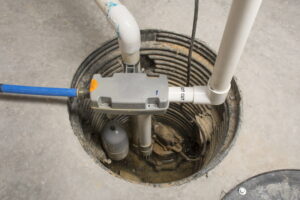If you have a sump pump, it has probably saved your behind—or at least your basement—on multiple occasions. Anyone who has cleaned up after water damage knows just how important it is to avoid having that happen again. Just knowing you have a sump pump at the ready can be extremely reassuring. But like any piece of machinery, sump pumps do encounter problems from time to time.
It might not feel like it, but spring is not too far away, and that’s the time of year when snowmelt and flooding make it most likely that your sump pump will have a lot of work to do. How can you be sure that your sump pump is in good working order and ready for whatever water comes its way?
General Guidelines
Every sump pump has its own specific instructions for care. The best way to be sure your pump will be happy is to read the owner’s manual that came with it. However, there is an organization called SSPMA, the Sump and Sewage Pump Manufacturer’s Association, and they do have some basic recommendations.
- Unplug: The pump should always be unplugged before you clean it, and make sure you remember to plug it back in when you’re done.
- Washing Machine Water: If your washing machine water is disposed of through your sump pump, you should clean the pump screen or inlet opening each month.
- Other Use: If your sump pump is not responsible for washing machine outflow, and instead just deals with other water sources, the pump screen or inlet opening should be cleaned every few months.
- Full Cleaning: Once a year, the sump pump should be taken out of the pit, and both pump and pit should be cleaned.
Professional Maintenance
If all this sounds confusing or overwhelming, don’t worry. There’s a simple solution. Schedule a maintenance appointment for sump pump service in Ashburn, VA. Your professional plumber will provide a thorough inspection for all the parts of your sump pump system and answer all your questions.
- Pit: Damage and cracking can sometimes occur in the basin or pit, so it will be checked to make sure it’s structurally sound.
- Check Valve: This component stops water from flowing backward into the pit. Your plumber will make sure it’s working properly.
- Power Source: Often, sump pumps have a backup power source, so they’ll keep working even when your electricity is out. If your sump pump system has this component, it will be inspected to make sure it will work during the worst storms.
- Alarm: Not all sump pumps have this, but if yours does, it will be tested so you’ll know you can rely on it.
- Cover: Your sump pit should be covered, and your plumber will check that it is secure. If your sump pit is uncovered, they will offer solutions.
- Discharge: There are requirements about where the water from your sump pump is discharged, and your plumber will help to make sure those are met.
- Recommendations: Your plumber will give you clear instructions on what maintenance you should be doing yourself and when, and they can show you exactly how to perform the tasks mentioned above, such as cleaning the pump screen. Then you can rest easy, knowing that your sump pump is in great condition, and that you have the skills you need to keep it that way.
AllTech Services, Inc. is your trusted resource for sump pump maintenance and all other plumbing needs. Contact us today!


